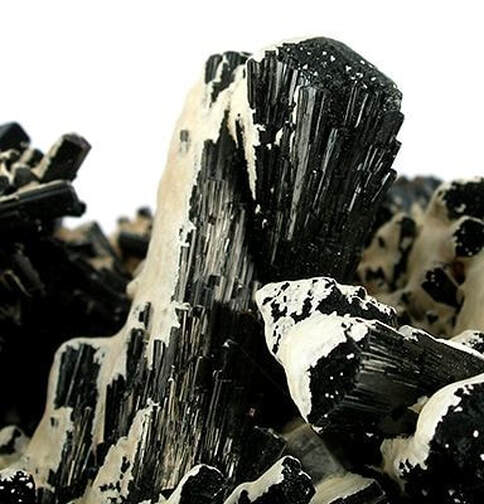Sentry Page Protection
Tourmaline
Schorl is the black variety
Vaikranta (Sanskrit)
Di Qi Shi (TCM)
Vaikranta (Sanskrit)
Di Qi Shi (TCM)
Photo: Rob Lavinsky, iRocks.com
Minerological name:
Tourmaline; Boron aluminosilicate
Parts used:
Prepared stone
There are various colored Tourmaline but only black is used in medicine.
Temperature & Taste:
Cool, dry. Pungent, Bitter, Salty. Tourmaline is said to have all 6 tastes in Ayurveda.
Properties:
Crystal system: Trigonal
Color: Black
Streak: Colorless
Cleavage: None; prismatic faces striated vertically
Fracture: Uneven
Luster: Vitreous
Tenacity: Brittle; sometimes friable
Hardness: 7-7.5
Specific Gravity: 3-3.2
Has Pyroelectric and Piezoelectric properties.
Not affected by acids
Constituents:
Sodium iron aluminum boro-silicate hydroxide (Na(Fe,Mn)3Al6B3Si6O27(OH)3(OH,F))
In descending order: Silicon, Iron, Sulphur, Boron, Calcium with traces of C, O, Na, Mg, Al, K, Cr, Mn and Zn
Tourmaline; Boron aluminosilicate
Parts used:
Prepared stone
There are various colored Tourmaline but only black is used in medicine.
Temperature & Taste:
Cool, dry. Pungent, Bitter, Salty. Tourmaline is said to have all 6 tastes in Ayurveda.
Properties:
Crystal system: Trigonal
Color: Black
Streak: Colorless
Cleavage: None; prismatic faces striated vertically
Fracture: Uneven
Luster: Vitreous
Tenacity: Brittle; sometimes friable
Hardness: 7-7.5
Specific Gravity: 3-3.2
Has Pyroelectric and Piezoelectric properties.
Not affected by acids
Constituents:
Sodium iron aluminum boro-silicate hydroxide (Na(Fe,Mn)3Al6B3Si6O27(OH)3(OH,F))
In descending order: Silicon, Iron, Sulphur, Boron, Calcium with traces of C, O, Na, Mg, Al, K, Cr, Mn and Zn
Uses:
1. Nourishes Yin, Benefits Essence:
-In Ayurveda it is classed as a Rasayana (Tonic to the 7 Body Tissues) and said to alleviate all 3 Dosas (Humors)
-makes the body strong; good for diseases of old age.
-Weakness, Anemia, Chronic and obstinate Illnesses including Tuberculosis.
-Sterility, Seminal disorders
-Obstinate Urinary diseases including Diabetes.
-used as a substitute for Diamond Bhasma in Ayurveda.
2. Clears Heat and Damp, Resists Poison:
-Fever.
-Jaundice, Syphilis and Gonorrhea
-Obstinate Abdominal Diseases including Ascites
3. Benefits the Lungs, Relieves Cough:
-Cough, Bronchitis, Dyspnoea;
-Chronic Lung disease including Tuberculosis.
4. Calms Mind and Spirit:
-eases Nervousness, calms the Mind
-aids Concentration, Intellect and Wit.
-traditionally used for a sense of Dread.
-traditionally used to Protect from Evil
Dose:
125–250mg of the Bhasma (Ayurveda)
Comment:
Tourmaline is often found in Diamond mines, and when turned into Bhasma, it is used for similar purposes to Diamond Bhasma. In modern times Tourmaline is often used as a substitute for Diamond Bhasma in Ayurveda.
Preparation:
It is used in the form of Bhasma.
To purify Tourmaline: It is boiled in Dola Yantra for 3 hours with a Decoction of Dolichos biflora. It is then submitted to Bhasma.
125–250mg of the Bhasma (Ayurveda)
Comment:
Tourmaline is often found in Diamond mines, and when turned into Bhasma, it is used for similar purposes to Diamond Bhasma. In modern times Tourmaline is often used as a substitute for Diamond Bhasma in Ayurveda.
Preparation:
It is used in the form of Bhasma.
To purify Tourmaline: It is boiled in Dola Yantra for 3 hours with a Decoction of Dolichos biflora. It is then submitted to Bhasma.
Main Combinations:
Cautions:
1. Standard cautions for using Gem stones.
2. According to the Ayurvedic Pharmacopeia of India it should not contain more than the following limits of Heavy metals and Arsenic: Lead 11 ppm; Arsenic 4 ppm, Cadmium 2ppm.
Main Preparations used:
1. Standard cautions for using Gem stones.
2. According to the Ayurvedic Pharmacopeia of India it should not contain more than the following limits of Heavy metals and Arsenic: Lead 11 ppm; Arsenic 4 ppm, Cadmium 2ppm.
Main Preparations used:
Click the Tabs above for more information on this Medicine

